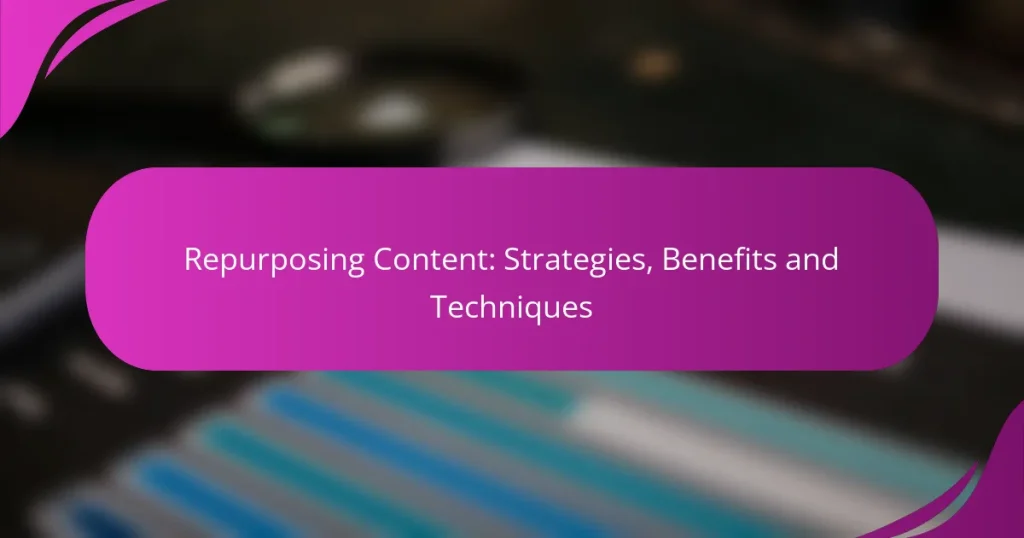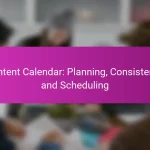Repurposing content is a strategic approach that involves transforming existing materials into various formats to engage new audiences and extend their lifespan. This technique not only maximizes the value of original content but also enhances SEO and audience engagement, making it a valuable practice for businesses looking to broaden their reach.
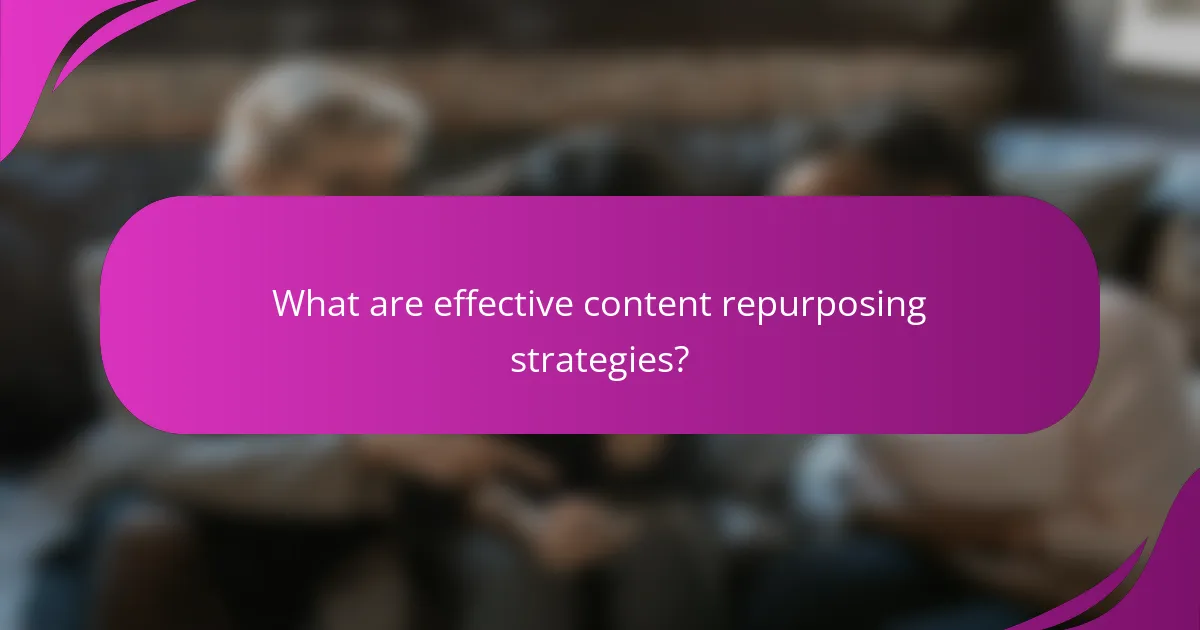
What are effective content repurposing strategies?
Effective content repurposing strategies involve transforming existing content into different formats to reach new audiences and extend its lifespan. This can enhance engagement, improve SEO, and maximize the value of your original content.
Transforming blog posts into videos
Transforming blog posts into videos can significantly increase viewer engagement. Start by summarizing the key points of your blog post and creating a script that flows well in a visual format. Use visuals, animations, or slides to complement your narration and keep the audience interested.
Consider platforms like YouTube or social media for distribution, as these channels can help you reach a broader audience. Aim for videos that are concise, ideally under five minutes, to maintain viewer attention.
Creating infographics from research articles
Creating infographics from research articles allows you to present complex data in a visually appealing way. Identify the most critical statistics and insights from your article, then design an infographic that highlights these points clearly.
Use tools like Canva or Piktochart to create infographics that are easy to share on social media and websites. Ensure that your visuals are not cluttered and maintain a logical flow to guide the viewer through the information.
Turning podcasts into written transcripts
Turning podcasts into written transcripts can make your audio content accessible to a wider audience, including those who prefer reading. Start by transcribing the audio, ensuring that the text is clear and easy to follow.
Once transcribed, consider editing for clarity and adding headings or bullet points to break up the text. This format can improve SEO and allow for easier sharing on platforms like LinkedIn or your website.
Developing social media posts from case studies
Developing social media posts from case studies can effectively highlight your successes and engage your audience. Extract key findings and insights from the case study, then create bite-sized posts that convey these messages succinctly.
Use compelling visuals and quotes to enhance engagement on platforms like Instagram or Twitter. Aim for a mix of formats, such as images, short videos, or carousel posts, to keep your audience interested.
Republishing old content with updates
Republishing old content with updates can breathe new life into valuable information that may have become outdated. Review your existing articles and identify those that can benefit from fresh data, insights, or examples.
When updating, ensure that you highlight the changes made and consider adding a note about the original publication date. This practice not only improves the content’s relevance but also boosts its visibility in search engines.
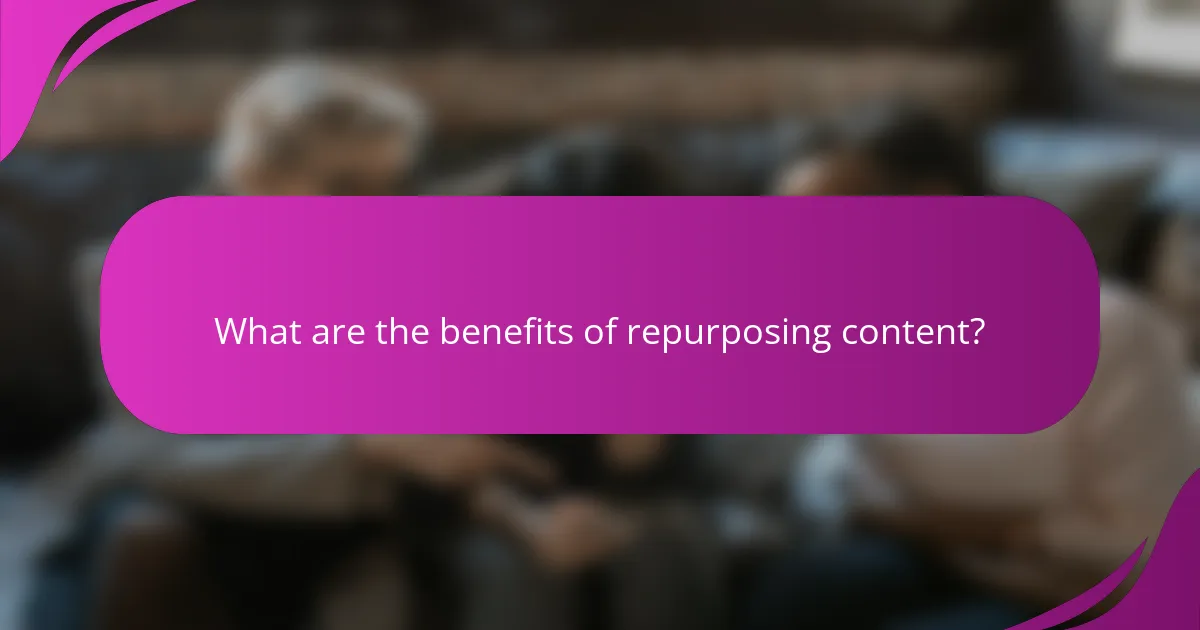
What are the benefits of repurposing content?
Repurposing content offers several advantages, including maximizing the value of existing materials and reaching a broader audience. By transforming content into different formats, businesses can engage various segments of their audience more effectively.
Increased audience reach
Repurposing content allows you to connect with different audience segments by presenting the same information in various formats. For instance, a blog post can be turned into a video, infographic, or podcast, catering to diverse preferences and consumption habits.
Consider using social media platforms to share repurposed content. Each platform has unique demographics, so adapting your content accordingly can significantly expand your reach and engagement.
Improved SEO performance
Repurposed content can enhance your SEO performance by creating multiple entry points for search engines. Different formats, such as videos or infographics, can rank for various keywords, increasing your visibility online.
Ensure that each repurposed piece includes optimized titles, descriptions, and relevant keywords. This strategy can lead to higher organic traffic and better search engine rankings over time.
Enhanced brand visibility
By consistently repurposing content across multiple channels, you reinforce your brand message and increase visibility. Each new format presents an opportunity to showcase your brand’s voice and expertise.
Utilize visual elements like logos and brand colors in all repurposed content to maintain a cohesive brand identity. This consistency helps in building recognition and trust among your audience.
Cost-effective marketing
Repurposing content is a cost-effective marketing strategy, as it maximizes the return on investment for your existing materials. Instead of creating new content from scratch, you can leverage what you already have, saving both time and resources.
To implement this strategy effectively, create a content calendar that outlines how and when to repurpose existing materials. This approach ensures that you maintain a steady flow of content without incurring additional costs.
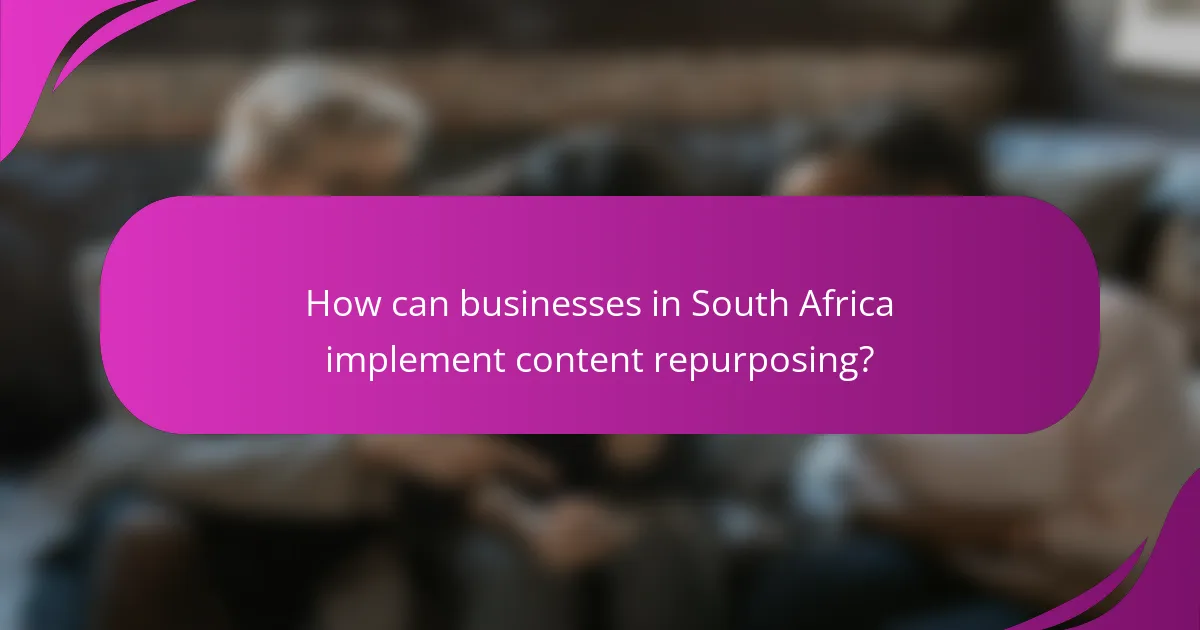
How can businesses in South Africa implement content repurposing?
Businesses in South Africa can implement content repurposing by strategically transforming existing materials into various formats tailored for different audiences. This approach not only maximizes the value of content but also enhances engagement and reach across diverse platforms.
Utilizing local case studies
Incorporating local case studies into repurposed content can significantly enhance relevance and relatability. For instance, a company could take a successful marketing campaign and create a detailed report or video showcasing its impact within a specific South African community.
When selecting case studies, focus on industries that resonate with your target audience. Highlighting familiar brands or businesses can foster trust and encourage engagement, making the content more impactful.
Engaging with regional influencers
Collaborating with regional influencers can amplify the reach of repurposed content. By partnering with influencers who have a strong following in South Africa, businesses can tap into new audiences and gain credibility.
Consider creating joint content pieces, such as interviews or co-hosted webinars, that leverage the influencer’s expertise and audience. This not only diversifies content formats but also enhances visibility across social media platforms.
Adapting content for local languages
Adapting content for local languages is crucial in a multilingual country like South Africa. Translating and localizing content ensures that it resonates with diverse linguistic groups, increasing accessibility and engagement.
When repurposing content, consider creating versions in Afrikaans, isiZulu, or isiXhosa, depending on your target demographic. This approach can significantly broaden your audience and demonstrate cultural sensitivity, fostering a stronger connection with local consumers.

What criteria should be considered for content repurposing?
When repurposing content, consider the target audience’s preferences, the suitability of different content formats, and the performance metrics of the original material. These criteria help ensure that the new content resonates with viewers and maximizes engagement.
Target audience preferences
Understanding your target audience’s preferences is crucial for effective content repurposing. Analyze their interests, demographics, and consumption habits to tailor the repurposed content accordingly. For instance, younger audiences may prefer video formats, while professionals might favor detailed articles or whitepapers.
Engage with your audience through surveys or social media to gather insights on their preferred content types. This feedback can guide your repurposing strategy, ensuring that the new content aligns with what your audience finds valuable.
Content format suitability
Different content formats serve various purposes and audiences. Assess which formats best convey your message and engage your audience. For example, a blog post can be transformed into an infographic, a video, or a podcast, depending on the context and audience preference.
Consider the strengths of each format. Infographics are great for visual learners, while podcasts can reach audiences during commutes. Choose formats that enhance the original content’s message and fit the consumption habits of your audience.
Performance metrics of original content
Evaluating the performance metrics of your original content is essential for effective repurposing. Look at engagement rates, shares, and conversion metrics to identify which pieces resonated most with your audience. High-performing content is often a good candidate for repurposing.
Utilize analytics tools to track these metrics over time. For example, if a blog post received significant traffic and engagement, consider converting it into a video or a series of social media posts to reach a broader audience. This data-driven approach maximizes the impact of your repurposed content.
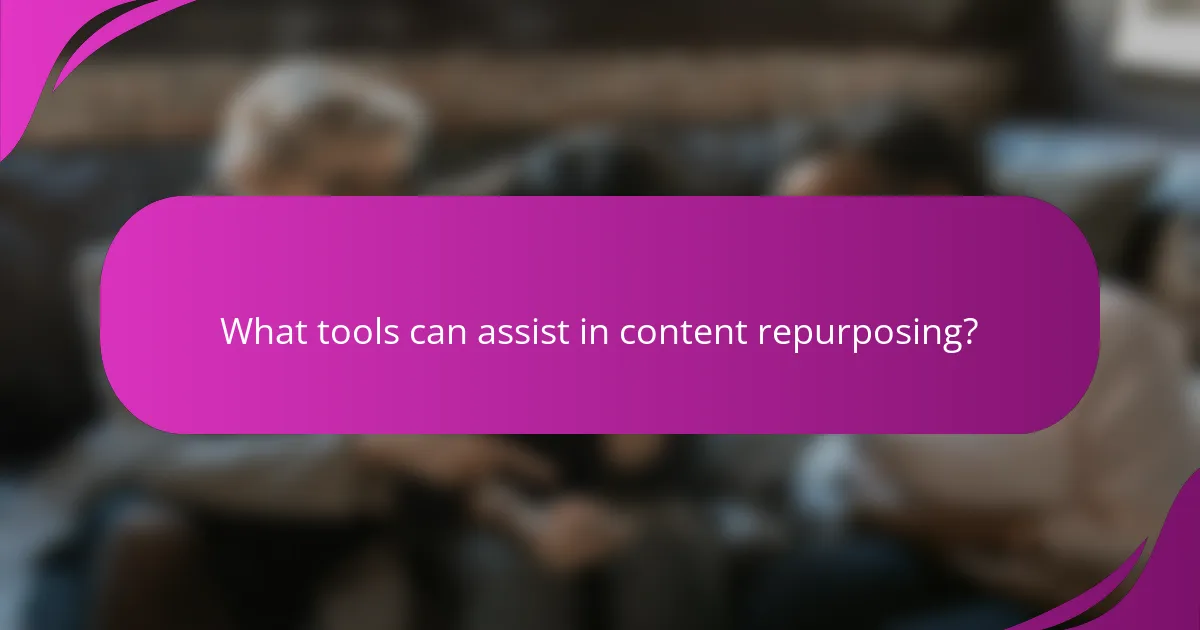
What tools can assist in content repurposing?
Several tools can streamline the content repurposing process, enhancing efficiency and creativity. Utilizing the right tools can help you transform existing content into various formats, reach wider audiences, and maximize your content’s lifespan.
Canva for design
Canva is a versatile design tool that allows users to create visually appealing graphics, infographics, and presentations from existing content. With its user-friendly interface and a vast library of templates, you can quickly adapt blog posts or articles into engaging visuals.
To effectively use Canva for repurposing, start by selecting a template that aligns with your content’s theme. Customize it with your text, images, and branding elements. This approach not only saves time but also enhances your content’s visual appeal, making it more shareable on social media platforms.
Hootsuite for social media scheduling
Hootsuite is a powerful social media management tool that helps you schedule and publish repurposed content across various platforms. By using Hootsuite, you can plan your posts in advance, ensuring consistent engagement with your audience.
To maximize your content’s reach, consider creating a content calendar that outlines when and where to share each piece. This strategy allows you to repurpose blog posts into multiple social media updates, adapting the messaging for each platform while maintaining a cohesive brand voice.
BuzzSumo for content analysis
BuzzSumo is an analytical tool that enables you to discover trending topics and analyze the performance of your content. By identifying what resonates with your audience, you can repurpose high-performing content into new formats or update it for relevance.
Utilize BuzzSumo to track engagement metrics, such as shares and comments, on your existing content. This insight can guide your repurposing efforts, helping you focus on topics that generate interest and engagement, ultimately enhancing your content strategy.
